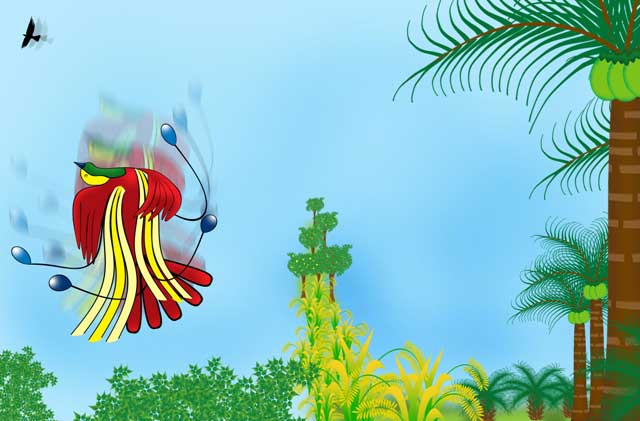
Illustration of Isharo by Sherri Maigne Meneses
Isharo, the beautiful bird of paradise, was preening her multicolored feathers on the topmost branch of a forest tree. The morning sun made her look like a jewel among green leaves. Isharo had always thought she was the most beautiful creature in the forest, until one day she glanced up and saw Kautatali.
Kautatali, the splendid bird feared and worshipped by all, swooped down from the heavens to rest on a large mountain tree. His feathers were the colors of the sun and his beautiful human-like body shone in the morning sun. His sharp golden beak and eyes missed nothing in the forest beneath. He glanced down and saw Isharo—just when Isharo glanced up.
Isharo had never seen such a big and beautiful bird and instantly fell in love with Kautatali. But Kautatali ignored her. He spread his wings and rose slowly in the air.
Isharo flapped her yellow-red wings and spread her fan-shaped tail to follow him. Just then, a man called up to her, “Isharo, Isharo, do not follow Kautatali.”
“Kautatali, what a beautiful name,” Isharo replied. “But I must follow for I love him.”
“Oh, Isharo!” the man said. “Kautatali is the king of birds. He flies the highest and the fastest among all winged creatures. He will never love you, for lovely though you are, you can never match him in flight.”
Ignoring the warning, Isharo spread her beautiful wings and rose above the forest canopy.
Kautatali was already high up, heading towards the sun. Isharo flew higher until she was above the mountains. In the cold air, her breath came fast and her little heart started beating faster. She had never flown so high.
Kautatali looked down at Isharo. “Go back, beautiful bird. You can never fly as high and as fast as me,” he said as he glided on an air current. “And I will marry none other.” Kautatali rose even higher.
“Oh, Kautatali, if you only knew how much I love you,” cried Isharo. And she flapped her wings even harder to reach him.
But, Kautatali circled the mountain and flew on.
Isharo was exhausted. She looked down at the forest way beneath. Then she set her eyes skywards and flew after Kautatali.
Alas, the bird of paradise was a delicate creature made for the forests. Isharo began to fall from the sky. Isharo tumbled down, down back into the forest—through the trees and into a forest clearing. Her little body was broken.
The man who had followed her flight sighed at the sight of the dying Isharo.
“I have failed to fly to Kautatali.” Isharo whispered with her last breath. “But I will not die in vain. Plant my eyes and you will never lack food.”
Indeed, Isharo’s death was not in vain. From her multicolored wings sprung the leaves of sago palm and fruit trees; from her tail grew the coconut tree. But the most important gift was from her golden eyes. Isharo’s eyes turned into beautiful rice grain.
And since then, people have had fruits and sago and coconut to eat. But most of all, they have rice to grow and never lacked food again.
The Torajas live in the highlands of South Sulawesi, Indonesia, and have cultivated rice from a very early time. They have detailed rituals for sowing and cultivating rice.
_________________________________________
Ms. Roy is a consultant at an international school in India. She devotes most of her time to writing and studying stories for children and teens.







